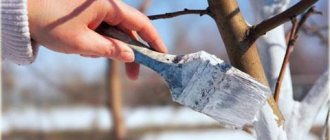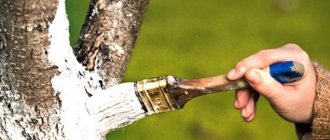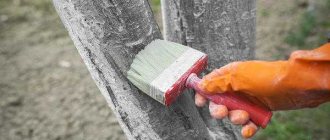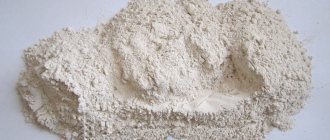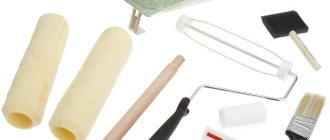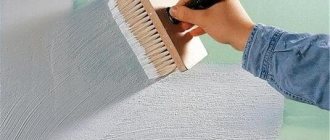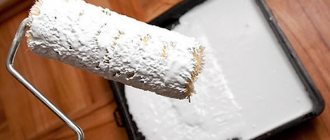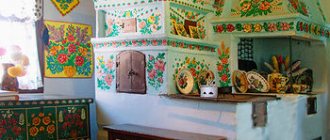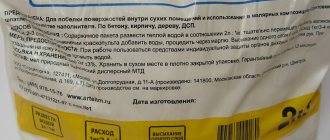Author: Elena N. https://floristics.info/ru/index.php?option=com_contact&view=contact&id=19 Category: Garden plants Published: February 05, 2019Last edits: January 06, 2021
- Preparations for whitewashing trees
Proper care of fruit trees is the key to their health, longevity, and abundant and high-quality harvest. Our website has already posted an article on how to whitewash trees in the fall, where we substantiated the need for this procedure. Autumn whitewashing of garden trees is a very important item in the list of garden care activities, but whitewashing trees and shrubs in the spring is no less important.
Why are trees whitewashed?
Many people living both in the city and in rural areas have a vague idea of why trees are whitewashed. Most believe that this is done simply for beauty. They are partly right, but there are still more important reasons for processing trunks.
Properly whitewashed wood
Why are tree trunks whitened?
- Sun protection. Direct rays are dangerous for the bark, which cracks under their influence. Therefore, tree trunks are treated with compositions of precisely white, light-reflecting colors. It is noteworthy that in winter the sun is no weaker in its impact than in summer, so it is important to protect trees all year round.
- Pest protection. Many gardeners know firsthand how often the bark of fruit trees is attacked by insects and rodents. Whitewash repels pests.
- Protection against temperature changes. Daytime heat and night cold cause the bark to deform and crack, which often leads to various types of infections getting inside the trunk. Whitewashing helps strengthen the bark, prevents the appearance of cracks, and has antibacterial properties.
Important! Trees should be whitewashed in dry weather so that the applied composition has time to set.
Benefits of paint
Modern means have a number of advantages over proven, but rather outdated types of processing:
- They guarantee protection not only from insects, but also from rodents.
- Reliably protect the tree trunk from possible sunburn.
- The paint is suitable for absolutely any plant.
- Moisture resistance increases significantly.
- You don't have to worry about trees in severe frosts.
- Whitewashing with paint can be used in places where branches have been cut or broken instead of special means.
- Protects the trunk from harmful insects that settle in the folds of the bark.
- After treatment, you can forget about diseases such as fruit rot, rust, scab and many others. There is an option, in addition to standard whitewashing, to treat the entire crown of the plant with paint diluted with water (1:10) using a sprayer. This will not only prevent diseases, but also protect against acid precipitation and the appearance of lichen on the branches.
When to whitewash trees
Many people believe that whitewashing trees is done only in early spring. In fact, spring treatment of the trunk is intended only to renew the layer of composition that has been slightly washed away over the winter. For many, the real news is the fact that most of the work is done in the fall.
Grafting trees in spring, methods of grafting fruit trees for beginners
It is in winter that the tree especially needs protection. In February, when the sun is already noticeably warming up, and severe frosts still linger at night, the most dangerous period begins. During the day, the process of sap flow may begin in the trunk; by evening, the liquid will freeze and injure the bark. That is why it is important to whitewash in advance, in the fall. If this has not been done, you will have to process the trunks in winter, in December-January.
Timing for whitewashing trees in autumn
It is best to carry out autumn treatment in October-November, when the leaves have already fallen off and prolonged rains are behind us. You need to choose a dry, cool day when the air temperature remains at 2-3°C.
Important! There is no need to spare the solution when working so that not a single crack in the bark is left unwhitened. It is also not necessary to smear the barrel too thickly, otherwise the whitewash will crumble. It is best to coat the stem with the composition in 2-3 doses.
How to whiten tree trunks
Grafting trees in spring, methods of grafting fruit trees for beginners
Whitewashing a tree is not difficult - just take a paint brush and apply the finishing compound to the trunk. It is advisable to paint the trunk from the very bottom, going 2 cm deep into the soil, to the roots, to the first branches. It is convenient to process fruits with a spray gun, but this will increase the consumption of whitewash.
You shouldn’t skimp on whitewashing – it won’t bring the desired result.
Covering half the barrel with white is not considered effective.
Lime for whitewashing trees
Protection from pests and diseases is the main reason why trees are whitened. Lime performs this function perfectly. Solutions based on it are easy to use, and the components used are not very expensive. As a rule, casein glue (or PVA) is added to the composition to make the whitewash stick better, and copper sulfate (as an antiseptic).
To process a large tree you will need about 1 kg of lime. It is not recommended to treat young trees with such an aggressive composition.
Is it possible to whitewash with water-based paint?
Water-based paints are quite suitable for painting trunks. They are distinguished by a higher price and ease of use - no additional components are required. However, they are not considered to be as effective as lime-based solutions.
Whitewash for trees
In specialized stores you can find a variety of preparations for whitewashing: from acrylic to chalk. Substances with reflective and antibacterial properties are added to their composition, which allows solving several problems at once.
Important! Many gardeners use a proven folk method of protecting trees - covering the trunk with a mash of clay and mullein.
Preparing for painting
Before applying paint, you should carefully prepare the tree bark. What needs to be done for this?
First of all, it is recommended to clean the surface of the bark from dust and dirt, as well as scrape off moss and all kinds of lichens. This can be done using a wire brush or scraper. It is recommended to collect and burn the peeled bark that falls down, as it may contain sleeping larvae or eggs of pests.
As a universal preventive measure, or if the tree has damage and cracks, the bark should be treated with garden varnish. It is also possible to impregnate the bark with alkaline agents to destroy possible microbes and parasites located in the trunk.
After such manipulations, the surface of the wood must completely dry, and only then will it be necessary to whitewash it.
How to dilute lime for whitewashing
Treating trees against pests and diseases
Lime is well known not only to builders, but also to gardeners. This substance is often used to treat the trunks of mature trees. Its antibacterial properties make it possible to protect the trunk and branches from the invasion of pathogenic microorganisms.
Lime fluff
How exactly to work with lime depends on its type.
How to prevent lime from washing away
To prevent the lime from being washed off from the trees for a long time, you will need to add additional components to the whitewash. There are 2 main options for mixtures for treating trees:
- 1 kg of lime and 2 kg of clay per 10 liters of water. In this composition, clay plays the role of a fixative.
- 3 kg of lime, 300 g of vitriol and 200 g of casein glue per 10 liters of water. The glue adheres to the bark, preventing the composition from flowing under snow and rain.
How to dilute slaked lime (fluff)
Fluff lime is a slaked variety of lime that can be sold as a batter or powder. It is diluted in a 2:1 ratio, that is, 2 liters of water are taken per 1 kg of bulk or dough-like composition. At the same time, water is poured in carefully, in portions, thoroughly mixing the composition. It should have the consistency of sour cream.
As additional components you can use:
- Glue (200 g), acting as an adhesive;
- Laundry soap (40 g in the form of shavings) to enhance the antibacterial effect;
- A solution of copper sulfate (300 g per 0.5 water) instead of soap;
- Clay (300-400 g), dissolved in water to the consistency of sour cream, it is added to the solution as an adhesive.
Important! Despite the fact that fluff is slaked lime, it is better not to use it for whitewashing young seedlings with thin bark.
How to dilute quicklime
Despite the fact that it is more convenient and faster to work with slaked lime, gardeners often advise beginners to use quicklime, or rather to slak it themselves. If you follow safety precautions, this is not difficult to do.
How to extinguish lime:
- Pour lime (3 kg) into a bucket.
- Carefully fill with water (7 l).
- Stir the mixture and leave for 1-2 hours until the reaction is complete.
When the container has cooled (heat is released during extinguishing), you can add other components to the solution, the same as for the fluff.
Important! Work with quicklime must be carried out using personal protective equipment (gloves, mask, goggles).
Is it possible to whitewash trees with chalk?
It is quite possible to replace lime in whitewashing with chalk. This substance has a more gentle effect, so it is often used to treat young trees.
The following mixture is popular among gardeners: 2 kg of chalk, 400 g of copper sulfate, 100 g of casein glue per 10 liters of water.
Whitewashing process
Treat the wood in the same way as with lime whitewash, having first cleaned the bark with a brush.
Means for disinfecting damaged areas
Chemical (Their supporters claim that other methods cannot achieve a good effect. Opponents say that if such mixtures are constantly used, they accumulate both in the soil and in the plant itself, and as a result have a detrimental effect on it):
- Iron sulfate, or rather its solution. To prepare the correct composition, you need to take the following proportion as a basis: for ten liters of water we take half a kilogram of the substance.
- Compositions with copper. If you are interested in pre- whitening trees with copper sulfate , then when diluting the mixture, use the same scheme as in the previous case.
- Powdered fungicides, quite potent, such as hom, phytosporin. When diluting, take very little, 30-40 grams for the same 10 liters of water will be quite enough.
- Oksikhom. Has broader abilities, unlike its counterpart. Therefore, it is worth reducing the dose of the substance by half, i.e. We take only 20 grams.
Natural:
- Infusion of ash. In order to knead it, you need ten liters of boiling water, into which you need to pour about 3 kilograms of ash, but do not forget to sift it first. This whole mixture will not stick to the surface of the wood unless a binder is added to it.
Regular laundry soap acts as glue. You won't need about a quarter of a standard briquette of 200 grams. After everything is ready, do not put off the work; you need to apply the mixture before it cools down.
- If you don’t want to bother with applying medications, you can use a sprayer. To do this, you should make ash liquor. We take water and ash in the same proportions as described above, combine and put on fire. When all this boils, the liquid we need is formed, and we use it for irrigation.
After such treatment, original patches need to be made on large open areas of plant tissue. This is protection from various kinds of dangers, and from premature and too rapid loss of moisture.
Garden pitch is the most favorite putty of gardeners. You can buy it in a store or make it yourself. If there are different alternative options. Garden stores offer various pastes, they are ready-made, you don’t need to mix or add anything.
how to properly carry out such a process as whitewashing garden trees :
- Do not try to spread the mixture with lime too much; a thin layer does not mean a good one. It should be quite dense, but not thick. If you use paint, you can apply a thinner composition.
- No precipitation. Keep an eye on the weather forecast; apply the solution on a dry day without rain. When it comes to applying paint, the temperature is also important, at least +3.
- Under no circumstances use anything you could find in your own basement for such a task. Whatever paint is not suitable, it may do more harm than good. Go to the store and look on the shelf for a product marked “ paint for whitewashing trees .”
Now another important point - how high should the whitewash layer reach? You have probably already noticed that the plants on city streets have very low “white skirts”. According to the standard, they are whitened to about a meter in height. Maximum – 1.20 m. And this is completely wrong. Such a modest “outfit” is not capable of protecting from frost.
If possible, apply the composition as high as possible. For an already strong plant, this is at least one and a half meters. Those. You must capture the entire trunk and a third of the thick branches, they are also called skeletal.
By the way, do not forget that you need to whiten not only as high as possible, but also as low as possible. Within reasonable limits. Before you begin, rake the soil around the base of the trunk a little to get the brush over it. And then return the soil to its place. The main thing is not to overdo it with depth. Otherwise, instead of doing good, you will cause harm.
Trees should be painted as close to the ground as possible and at least to the skeletal branches.
How to spray trees in spring
Before spraying, the tree bark is cleaned of exfoliated areas, lichens, and adhering dirt. This can be done conveniently with a stiff brush. You can put a tarp on the ground to make it easier to remove accumulated debris.
Afterwards it is worth inspecting the barrel for damage. If there are open areas without bark, it is advisable to cover them with garden pitch.
Then you need to put on a protective suit or old thick clothing with long sleeves, gloves and a mask. Be sure to have a hat.
Prepare a solution of the drug according to the instructions and pour it into the spray bottle. Spray the branches, trunk and trunk circle, trying not to miss anything.
Note! It is advisable to notify your neighbors about the work being carried out so that they can hurry to spray the trees. Joint protection will prevent diseases from spreading from site to site.
Selecting a device
Preparing for whitewashing trees also includes choosing the right tools. First of all, think about what would be more convenient for you to paint with – a brush, a roller or a spray gun. In addition to personal preference, you should pay attention to the special purpose of each tool.
For example, thanks to the right brushes, you can use garden paint economically. Rollers will help paint thick tree trunks with equal precision, and will also facilitate the penetration of liquid into various cracks and depressions formed on the surface of the bark. Modern spray guns will save time and effort, since with their help, painting trees will be carried out several times faster than with the tools listed above.
When choosing dyeing devices, it is also recommended to take into account their size so that they match the thickness of the trunk and branches of garden plants.
During the work, you can use several tools, combining them with each other depending on the surface of the tree or shrub.
When to spray
Do not delay the start of treating fruit with insecticides. Insects awaken from the first warmth, so if the spring turns out to be good, the time to spray comes already in March. The most convenient time for whitewashing and spraying comes in April.
The maximum effect can be achieved by treating the trees twice. The first spraying is carried out before the buds open, when the air temperature reaches 5°C. At this time, fungal spores are already activated.
The second spraying is carried out along the green cone, that is, when the buds have already opened, but the leaves have not yet had time to bloom. At this time, flower beetle pests wake up.
Spraying in early spring
In the spring, fruit trees can be sprayed for treatment twice more: at the stage of a pink bud and ovary, the size of a pea. This will protect the crop from moniliosis and codling moth.
Why should you paint?
Caring for trees in the garden begins in early spring, when the snow barely begins to melt and the first streams flow. Just at this time, when the insects have not yet woken up and the pests have not had time to crawl out of their underground burrows, special paint should be applied to the trees. It will protect the plants from parasites, preventing them from penetrating the tree trunk. If the insects overwintered in the folds of tree bark, then the paint will prevent their further life activity.
As you can see, this method is very useful, as it protects the plant from uninvited guests, promotes its healthy appearance and an abundant, tasty harvest.
What types of protective garden paints are there and how should they be used? Let's find out.
Preparations for spraying trees
There are many products that can help rid your garden of pests.
How to spray trees in spring, the most effective preparations:
- Copper sulfate. It can not only be added to whitewash, but also used for spraying. Vitriol copes well with various types of rot, scab, and spotting. Iron sulfate has the same properties;
- Urea (urea). It is often used as a fertilizer, but it also brings considerable benefits in pest control. Fights coccomycosis, moniliosis, rot;
- Bordeaux mixture. An indispensable gardener's assistant that can be used to treat trees and shrubs before flowering.
Knowing what and when to whiten trees in the spring, you can protect your harvest from many troubles. Lime works well against pests, diseases and bark destruction. Chalk and acrylic-based paints are no less effective. A solution with additional components will last a long time, preventing the trees from getting sick.
Popular manufacturers and brands
A wide range of white acrylic paints are produced for whitewashing tree trunks and shrubs. Their purpose can be easily determined by the external design of the packaging - each bucket traditionally contains images of a garden, individual trees or fruits.
The most common and accessible products are those manufactured by the following brands:
The greatest demand among experienced gardeners is acrylic paint “Universal” from Tex. It is suitable for whitewashing any garden and park crops. This composition can be used to paint over saw cuts, cover up cracks and wounds in places where the bark is damaged. The paint dries within 60 minutes, and the applied coating is not washed off for 1-2 years.
Source: vmirekraski.ru
